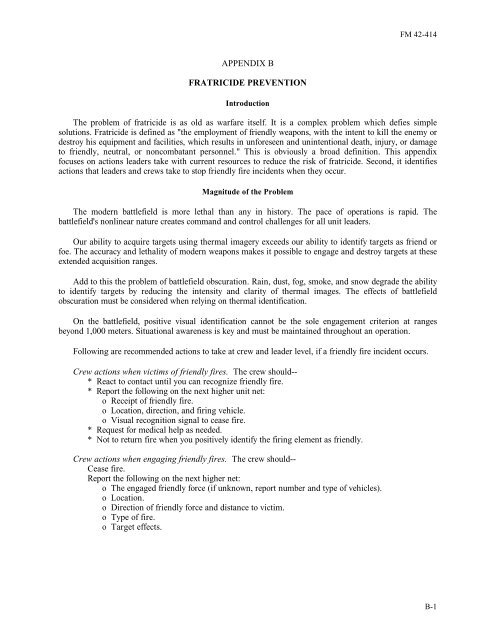Tactics, techniques, and procedures for - Army Electronic ...
Tactics, techniques, and procedures for - Army Electronic ...
Tactics, techniques, and procedures for - Army Electronic ...
Create successful ePaper yourself
Turn your PDF publications into a flip-book with our unique Google optimized e-Paper software.
APPENDIX B<br />
FRATRICIDE PREVENTION<br />
Introduction<br />
FM 42-414<br />
The problem of fratricide is as old as warfare itself. It is a complex problem which defies simple<br />
solutions. Fratricide is defined as "the employment of friendly weapons, with the intent to kill the enemy or<br />
destroy his equipment <strong>and</strong> facilities, which results in un<strong>for</strong>eseen <strong>and</strong> unintentional death, injury, or damage<br />
to friendly, neutral, or noncombatant personnel." This is obviously a broad definition. This appendix<br />
focuses on actions leaders take with current resources to reduce the risk of fratricide. Second, it identifies<br />
actions that leaders <strong>and</strong> crews take to stop friendly fire incidents when they occur.<br />
Magnitude of the Problem<br />
The modern battlefield is more lethal than any in history. The pace of operations is rapid. The<br />
battlefield's nonlinear nature creates comm<strong>and</strong> <strong>and</strong> control challenges <strong>for</strong> all unit leaders.<br />
Our ability to acquire targets using thermal imagery exceeds our ability to identify targets as friend or<br />
foe. The accuracy <strong>and</strong> lethality of modern weapons makes it possible to engage <strong>and</strong> destroy targets at these<br />
extended acquisition ranges.<br />
Add to this the problem of battlefield obscuration. Rain, dust, fog, smoke, <strong>and</strong> snow degrade the ability<br />
to identify targets by reducing the intensity <strong>and</strong> clarity of thermal images. The effects of battlefield<br />
obscuration must be considered when relying on thermal identification.<br />
On the battlefield, positive visual identification cannot be the sole engagement criterion at ranges<br />
beyond 1,000 meters. Situational awareness is key <strong>and</strong> must be maintained throughout an operation.<br />
Following are recommended actions to take at crew <strong>and</strong> leader level, if a friendly fire incident occurs.<br />
Crew actions when victims of friendly fires. The crew should--<br />
* React to contact until you can recognize friendly fire.<br />
* Report the following on the next higher unit net:<br />
o Receipt of friendly fire.<br />
o Location, direction, <strong>and</strong> firing vehicle.<br />
o Visual recognition signal to cease fire.<br />
* Request <strong>for</strong> medical help as needed.<br />
* Not to return fire when you positively identify the firing element as friendly.<br />
Crew actions when engaging friendly fires. The crew should--<br />
Cease fire.<br />
Report the following on the next higher net:<br />
o The engaged friendly <strong>for</strong>ce (if unknown, report number <strong>and</strong> type of vehicles).<br />
o Location.<br />
o Direction of friendly <strong>for</strong>ce <strong>and</strong> distance to victim.<br />
o Type of fire.<br />
o Target effects.<br />
B-1

















